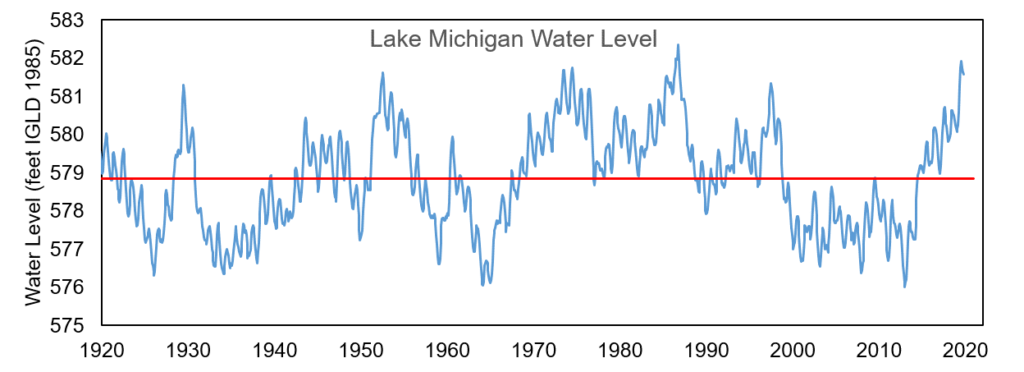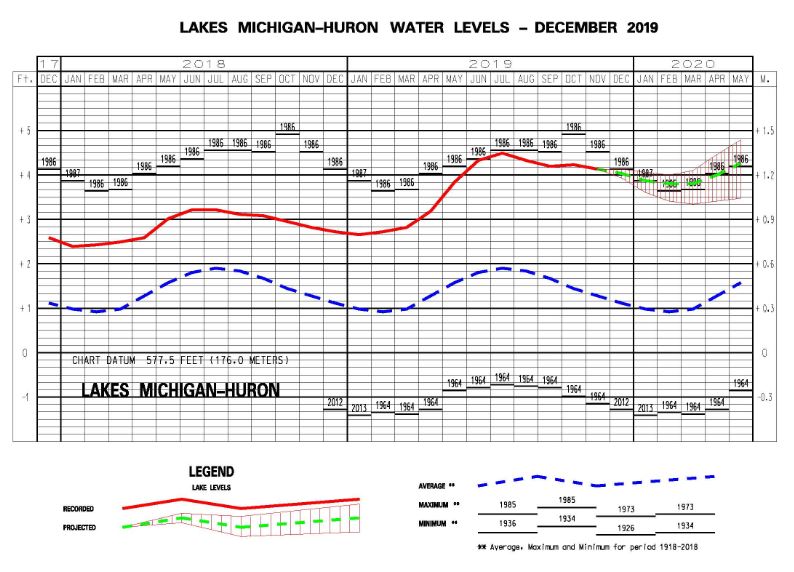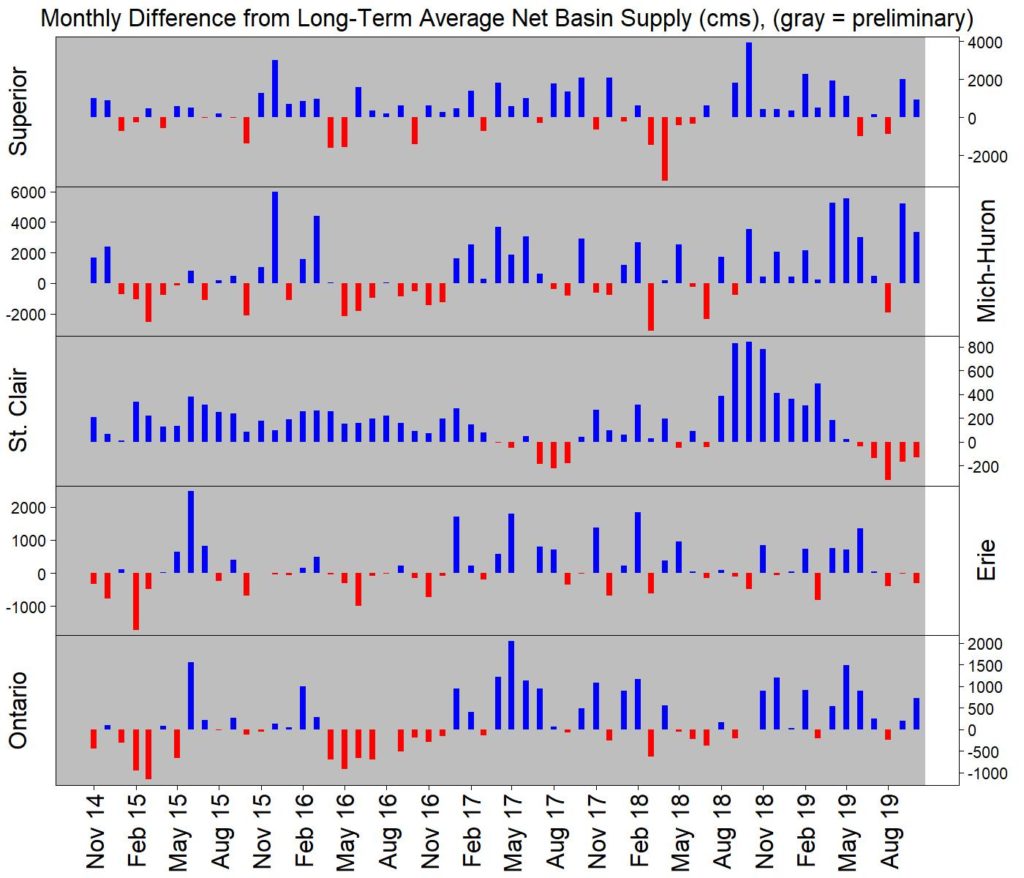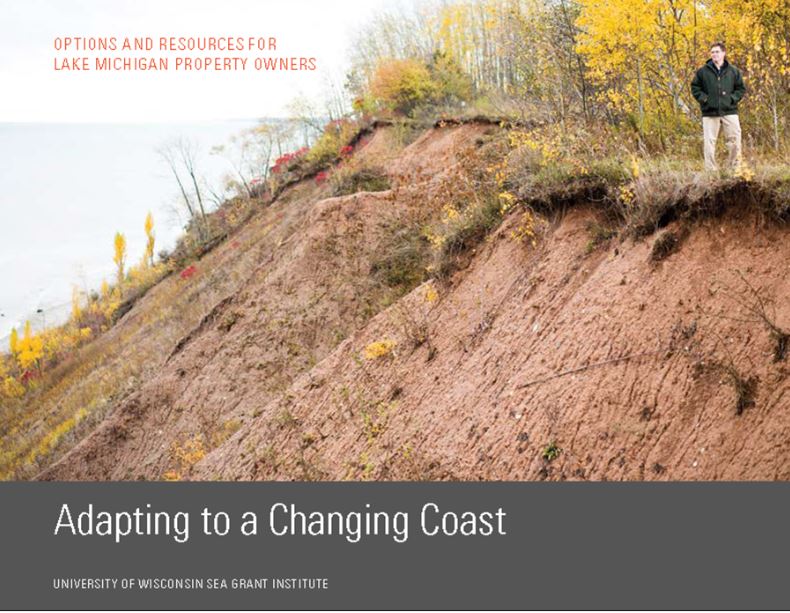
December 6, 2019
By Lydia Salus, Coastal Resilience Project Assistant, Wisconsin Sea Grant
The water levels on all the Great Lakes remain above average into December. Lake Michigan is currently at the same level as the highest monthly average that was set for the Lake in December of 1986. However, the Great Lakes Basin was relatively dry over the past month and as a whole received just two-thirds of its average precipitation in November.
Here are five things to know about water levels on Lake Michigan for December 2019.
What are the current water levels on Lake Michigan?
The water level of Lake Michigan as of December 6, 2019 is at an elevation of 581.59 feet above sea level (from the International Great Lakes Datum). To put this level into perspective, here are some statistics for Lake Michigan relative to the period of water level records measured from 1918 to 2018: (statistics from U.S. Army Corps of Engineers Weekly Water Level Update)
| Compared to… | Current Water Levels are… |
| One month ago | ~1 inch lower |
| One year ago | 16 inches higher |
| Average December (from 1918 to 2018) | 37 inches higher |
| Record December monthly mean (set in 1986) | Currently same as record high monthly average |
| Record high for any month (set in October 1986) | 9 inches below |
What is the outlook for future water levels?
The US Army Corps of Engineers projects higher than average water levels to persist over the next several months for Lakes Michigan-Huron (see six-month forecast issued for December 2019 below). With water levels at near-record high levels already, the forecast indicates a high likelihood of record or near-record water levels again in 2020.
Water levels are in the midst of their their seasonal decline, with a projected drop of about 2 inches by January 6th, 2019. This decrease in water levels is expected throughout the winter as precipitation and runoff into the lakes typically decreases and evaporation from the lakes increases. In an average year, water levels vary seasonally by about one foot from a peak in summer to a low in winter, though every year is different. Water levels would be expected to begin a seasonal rise again next spring when runoff and precipitation increase.

Six month water level forecast for Lake Michigan issued December 2019. Source: U.S. Army Corps of Engineers – https://www.lre.usace.army.mil/Missions/Great-Lakes-Information/Great-Lakes-Water-Levels/Water-Level-Forecast/Monthly-Bulletin-of-Great-Lakes-Water-Levels
Why are lake levels so high?
The story of Great Lakes water level changes is told by Net Basin Supply. Net Basin Supply accounts for water going into a lake in the form of precipitation and runoff minus water leaving a lake due to evaporation of water from the lake surface. In general, when Net Basin Supply is positive, more water enters the lake than leaves, yielding a rise in lake levels. Over the last five years, Net Basin Supply has been consistently positive, driving all the Great Lakes to rise. This is shown in the graph below, where blue indicates a positive Net Basin Supply and red is a negative Net Basin Supply – note there’s a lot more blue than red.
Lakes Michigan-Huron saw a positive Net Basin Supply in November 2019 despite drier conditions likely due to the influence of enhanced runoff from the wet weather in October.

Net Basin Supply to the Great Lakes, where blue indicates a positive NBS and red is a negative NBSSource: US Army Corps of Engineers – http://lre-wm.usace.army.mil/ForecastData/GLBasinConditions/monthlyNBSPast5Years.jpg
What would make water levels go down?
The historic record shows that water levels in the Great Lakes rise and fall with changes in precipitation and evaporation, so we know our high water levels will not be around forever. But what are the perfect conditions that would help water levels go down sooner rather than later? According to Keith Kompoltowicz, chief of watershed hydrology at the U.S. Army Corps of Engineers’ Detroit district “A cool, dry fall would evaporate water from the lakes because the lakes are relatively warm. As we move into the winter, we don’t want a healthy snowpack. We want a warm, snowless winter followed by a warm, dry spring.” Those would be the ideal conditions – low precipitation and runoff with high evaporation – to get a below average Net Basin Supply which would draw down lake levels a bit. This fall, Lakes Michigan-Huron continued to see higher than average precipitation so it is unlikely that water levels will go down as we roll in to 2020.
Where can I go for more information?
 See our Coastal Hazards page for details about the impacts of high water levels, including erosion, flooding, and navigation issues.
See our Coastal Hazards page for details about the impacts of high water levels, including erosion, flooding, and navigation issues.
Our blog post Resources for Great Lakes Coastal Property Owners: Where do I start? and Resilience Resources have links to many resources to help understand coastal hazards, weigh the risks coastal hazards pose to property, understand options for addressing these hazards, and get started on implementing actions if necessary. One featured resource includes Adapting to a Changing Coast: Options and Resources for Lake Michigan Property Owners (pictured right)
Great Lakes Water Budgets from the University of Michigan gives a bit more information into what makes the lakes go up and down
The US Army Corps’ Great Lakes Information page has tons of details on water levels. For more information, check out our Resource of the Month feature here.






